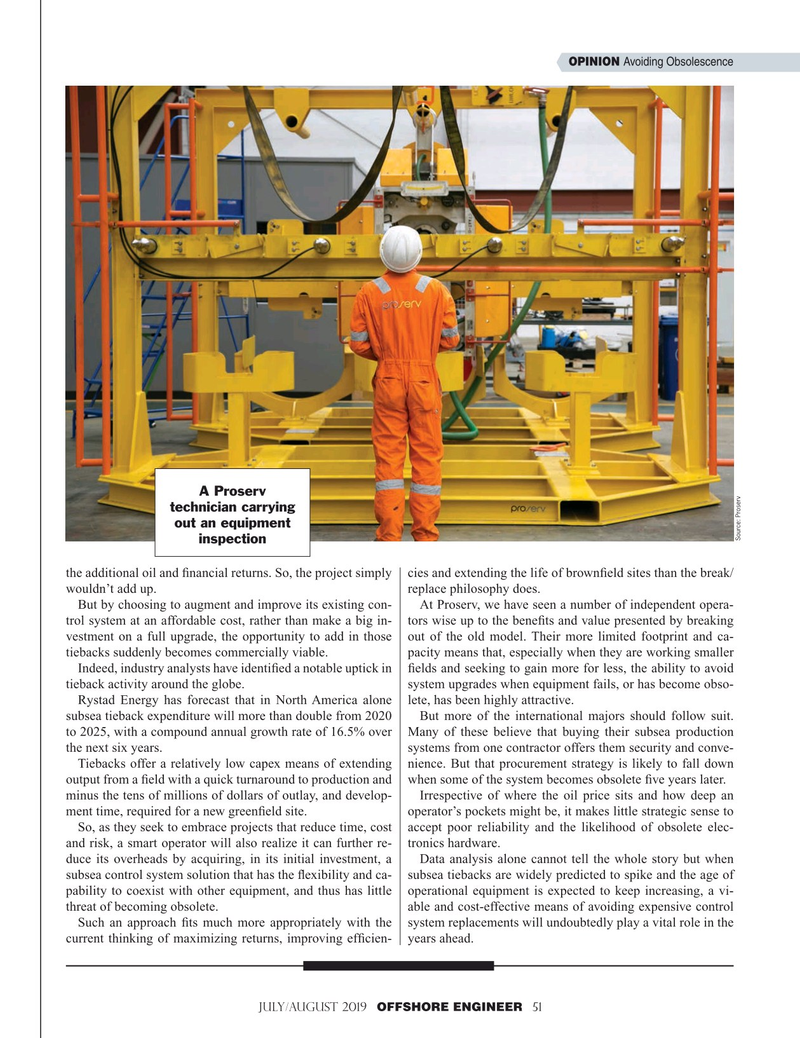
Page 51: of Offshore Engineer Magazine (Jul/Aug 2019)
Subsea Processing
Read this page in Pdf, Flash or Html5 edition of Jul/Aug 2019 Offshore Engineer Magazine
OPINION Avoiding Obsolescence
A Proserv technician carrying out an equipment
Source: Proserv inspection the additional oil and ? nancial returns. So, the project simply cies and extending the life of brown? eld sites than the break/ wouldn’t add up. replace philosophy does.
But by choosing to augment and improve its existing con- At Proserv, we have seen a number of independent opera- trol system at an affordable cost, rather than make a big in- tors wise up to the bene? ts and value presented by breaking vestment on a full upgrade, the opportunity to add in those out of the old model. Their more limited footprint and ca- tiebacks suddenly becomes commercially viable. pacity means that, especially when they are working smaller
Indeed, industry analysts have identi? ed a notable uptick in ? elds and seeking to gain more for less, the ability to avoid tieback activity around the globe. system upgrades when equipment fails, or has become obso-
Rystad Energy has forecast that in North America alone lete, has been highly attractive.
subsea tieback expenditure will more than double from 2020 But more of the international majors should follow suit. to 2025, with a compound annual growth rate of 16.5% over Many of these believe that buying their subsea production the next six years. systems from one contractor offers them security and conve-
Tiebacks offer a relatively low capex means of extending nience. But that procurement strategy is likely to fall down output from a ? eld with a quick turnaround to production and when some of the system becomes obsolete ? ve years later.
minus the tens of millions of dollars of outlay, and develop- Irrespective of where the oil price sits and how deep an ment time, required for a new green? eld site. operator’s pockets might be, it makes little strategic sense to
So, as they seek to embrace projects that reduce time, cost accept poor reliability and the likelihood of obsolete elec- and risk, a smart operator will also realize it can further re- tronics hardware.
duce its overheads by acquiring, in its initial investment, a Data analysis alone cannot tell the whole story but when subsea control system solution that has the ? exibility and ca- subsea tiebacks are widely predicted to spike and the age of pability to coexist with other equipment, and thus has little operational equipment is expected to keep increasing, a vi- threat of becoming obsolete. able and cost-effective means of avoiding expensive control
Such an approach ? ts much more appropriately with the system replacements will undoubtedly play a vital role in the current thinking of maximizing returns, improving ef? cien- years ahead.
JULY/AUGUST 2019 OFFSHORE ENGINEER 51

 50
50

 52
52